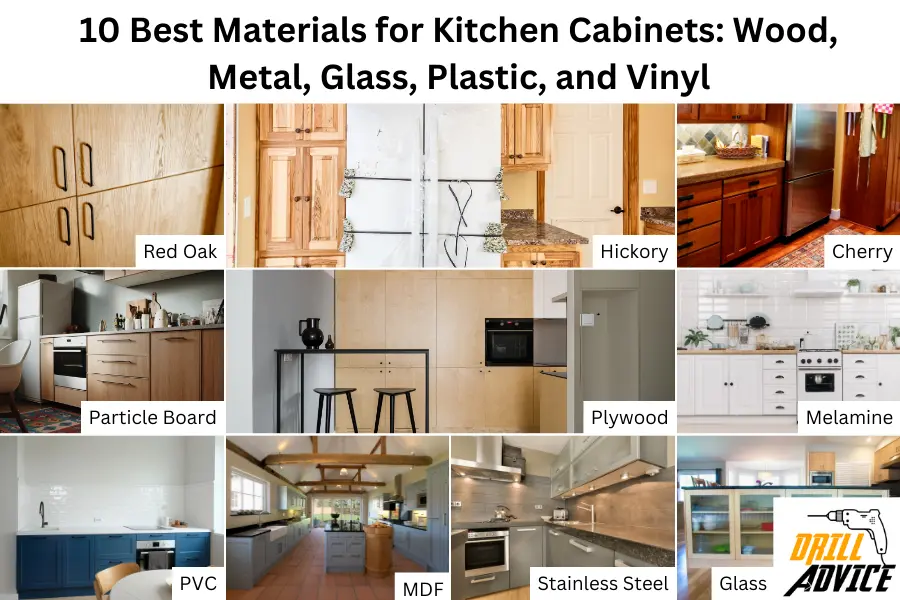
Kitchen cabinets are storage compartments in the kitchen. Kitchen cabinet material is important when selecting or buying a kitchen cabinet. You should consider price of the kitchen cabinet material, durability, workability and aesthetic appeal of the material.
By considering all the factors, these are the best 11 kitchen cabinet materials such as red oak, hickory, and cherry, particle board, plywood, melamine, PVC, MDF, stainless steel and glass.
These materials are strong, have higher workability, less insect attraction, less weight, have a higher surface finish, easy to maintain, and are available in affordable prices. Hence, these materials can be used as kitchen cabinet materials.
Each of these materials has both pros and cons. But overall, all of this material is good for making kitchen cabinets.
What Should Consider Before Selecting a Kitchen Cabinet Material?
Before selecting a kitchen cabinet material, you should consider the price, durability, workability, and aesthetic appeal of the material.
Price of the Kitchen Cabinet Material
The price of kitchen cabinet materials can vary based on several factors. Firstly, the thickness of the material. Thicker materials tend to be more expensive than thinner ones.
Secondly, the quality of the material also impacts its price. Higher-quality materials, such as solid wood or plywood, generally cost more than lower-quality options. Additionally, the type of material chosen, such as MDF (medium-density fiberboard) or particleboard, can affect the price.
Lastly, the workability of the material, including its ease of fabrication and installation, can also influence its cost. It is essential to consider all these factors when determining the budget for your kitchen cabinets.
Durability of the Kitchen Cabinet Material
Kitchen cabinet material should be highly durable and withstand everyday kitchen activities. The kitchen environment exposes cabinets to moisture, heat, fire, and the risk of insect infestation.
Therefore, it is essential to opt for materials that are resistant to these elements. High-quality materials like solid wood and plywood are known for their durability and can withstand the effects of water, heat, fire, and insects. On the other hand, lower-quality materials like particleboard or MDF may be less durable and more susceptible to damage. Prioritizing durability ensures that your kitchen cabinets will last longer and require less maintenance.
Workability of Kitchen Cabinet Material
The workability of the kitchen cabinet material is how easy it is to work with during fabrication and installation. When it comes to kitchen cabinets, considering the weight, cutting, drilling, and finishing of the material is important. Solid wood, for example, is heavier than other materials such as MDF or particleboard. This weight can impact the ease of transportation and installation.
Additionally, some materials may be more difficult to cut and drill compared to others. Solid wood, for example, requires specialized tools and expertise for precise cuts and holes. Lastly, the finishing process may also vary depending on the material. It is important to consider these factors when choosing a material that suits your woodworking skills and requirements.
Aesthetic Appeal of Kitchen Cabinet Material
Apart from functionality, the aesthetic appeal of kitchen cabinet material is also important. Different materials offer varying aesthetics, and it is important to select one that suits your overall kitchen design.
Solid wood provides a natural and timeless look that complements various styles. However, it is essential to note that the aesthetic appeal of certain materials may diminish over time. For example, painted MDF or particleboard cabinets may show signs of wear and tear more quickly than solid wood. It is important to consider the long-term appearance of the material and choose one that will maintain its aesthetic appeal for years to come. Regular maintenance and proper care can help preserve the beauty of your kitchen cabinets.
Read More About – 18 Best Kitchen Countertop Materials: Budget, Resistance, Maintenance, and Aesthetic Appeal
What are the 11 Types of Material For Kitchen Cabinets?
The 11 Types of Kitchen cabinet materials are;
- Red Oak
- Hickory
- Cherry
- Particle Board
- Plywood
- Melamine
- PVC
- MDF
- Stainless Steel
- Glass
1. Red Oak
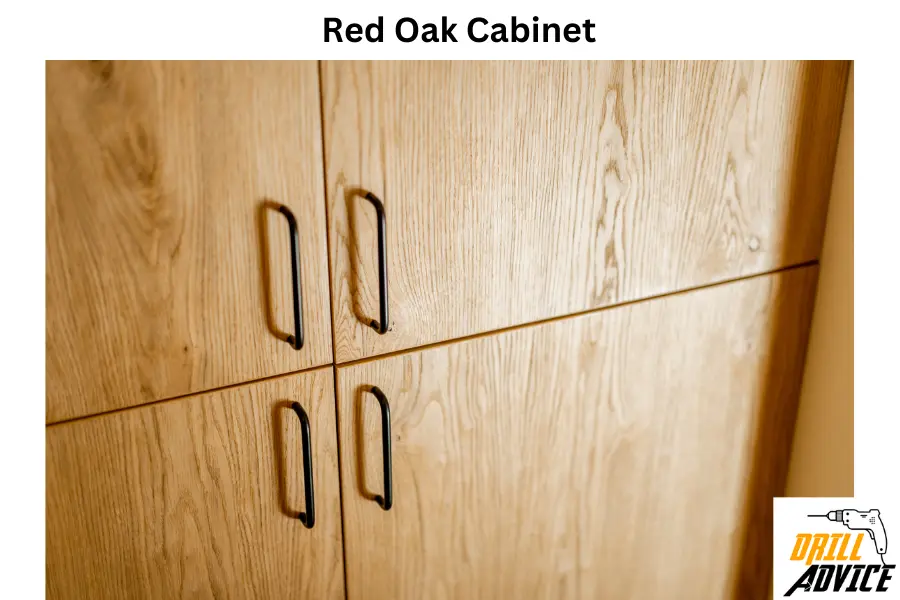
When considering the price of kitchen cabinet materials, Red Oak is a popular and affordable choice. On average, Red Oak can cost around $20 to $30 per linear foot. This price is relatively lower compared to other solid wood options.
Red Oak is an excellent choice for kitchen cabinets. It is recommended for its ability to withstand regular wear and tear, lasting for many years. However, it is important to note that Red Oak is susceptible to water damage, so it is essential to promptly wipe away any spills or moisture to avoid warping or staining. While Red Oak has good heat resistance, it is still important to use trivets or mats when placing hot objects on the surface. Additionally, Red Oak is moderately resistant to fire and insects, providing an added layer of protection for your kitchen cabinets.
Red Oak is a versatile material to work with, both in terms of weight and workability. It is moderately heavy, providing a sturdy feel to the cabinets. When it comes to cutting and drilling, Red Oak is relatively easy to work with compared to other solid woods. It can be easily shaped and customized to fit your specific design requirements. In terms of finishing, Red Oak takes stain and paint well, allowing for a wide range of design possibilities.
Red Oak offers a timeless aesthetic appeal for kitchen cabinets. It has a distinct grain pattern and warm reddish-brown color add a touch of natural beauty to any kitchen. Over time, Red Oak develops a rich patina, further enhancing its visual appeal and adding character to the cabinets.
Advantages of Red Oak
- It is affordable price compared to other solid wood options.
- Durable and long-lasting, with good resistance to wear and tear.
- Versatile workability, allowing for customization and easy installation.
- Timeless aesthetic appeal, with a distinct grain pattern and warm color.
Disadvantages of Red Oak
- Susceptible to water damage, requiring regular maintenance and prompt cleaning of spills.
- Moderate resistance to fire and insects, necessitating proper precautions.
- It can develop scratches and dents over time, although these can add character.
- Requires regular staining or finishing to maintain its appearance and protect against wear.
2. Hickory
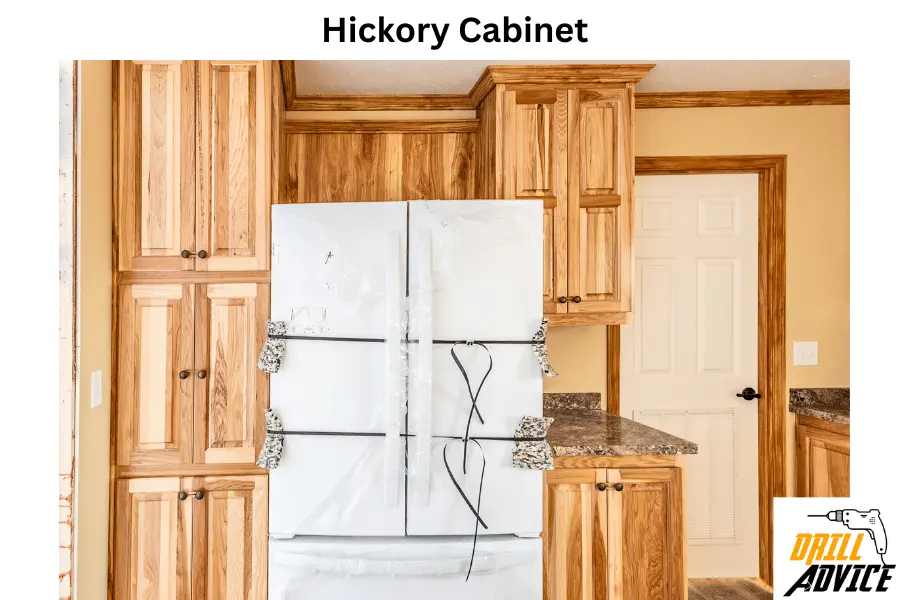
Hickory kitchen cabinet material costs around $5-$8 per board foot. Hickory is a popular choice for those looking for quality cabinets at a reasonable price.
Hickory is known for its exceptional durability, making it an excellent choice for kitchen cabinets. It is highly recommended for its ability to withstand daily wear and tear. Additionally, hickory is resistant to water, heat, fire, and insects, ensuring that your cabinets will maintain their quality and appearance for years.
Hickory is a dense and heavy material. This density can also make it more challenging to cut and shape compared to solid wood. It is recommended to use high-quality tools and blades specifically designed for working with hickory. Drilling may require a bit more effort due to the density. When it comes to finishing, hickory can be stained or painted to achieve the desired look, just like solid wood.
Hickory is widely admired for its natural beauty and unique grain patterns. It has a warm, rustic appearance that adds character and charm to any kitchen. Over time, hickory develops a beautiful patina, enhancing its aesthetic appeal. This material is a great choice for those who appreciate the natural beauty of wood and want their cabinets to stand out.
Advantages of Hickory Kitchen Cabinet Material
- Exceptional durability, resistant to water, heat, fire, and insects.
- Cost-effective compared to solid wood.
- Natural beauty with unique grain patterns.
- Adds warmth and character to the kitchen.
- Develops a beautiful patina over time.
Disadvantages of Hickory Kitchen Cabinet Material
- Dense and heavy, making it more challenging to work with compared to solid wood.
- Requires high-quality tools and blades for cutting and shaping.
- Drilling may require more effort due to the density.
3. Cherry
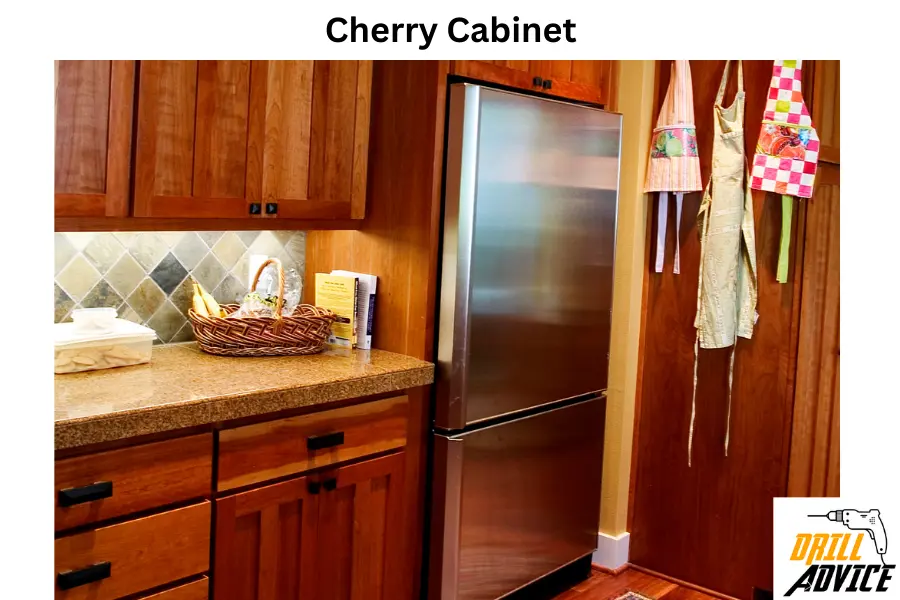
Cherry kitchen cabinet material is priced at around $4-$7 per board foot. Compared to solid wood, it is considered a higher-end option and may be more expensive. However, the price reflects the quality and beauty of cherry wood for cabinets.
Cherry wood is renowned for its durability, making it an excellent choice for kitchen cabinets. It is recommended for its ability to withstand daily use and maintain its integrity over time. Cherry wood is also resistant to water, heat, fire, and insects, ensuring that your cabinets will remain in excellent condition for years to come.
Cherry wood is moderately heavy and has a fine, straight grain, making it relatively easy to work with. Cherry wood can be cut and shaped using standard woodworking tools. Drilling into cherry wood is also straightforward. When it comes to finishing, cherry wood takes stains and finishes exceptionally well, allowing you to achieve a smooth and beautiful appearance. It is comparable to solid wood in terms of workability.
Cherry wood is highly regarded for its natural beauty and luxurious appearance. It has a warm, reddish-brown colour that deepens and develops a rich patina over time, adding to its aesthetic appeal. Cherry wood cabinets bring a touch of elegance and sophistication to any kitchen. The grain patterns of cherry wood are usually straight and smooth, giving it a refined and timeless look.
Advantages of Cherry Kitchen Cabinet Material
- Exceptional durability and resistance to water, heat, fire, and insects.
- Natural beauty with a warm, reddish-brown color and a rich patina that develops over time.
- Easy to work with using standard woodworking tools.
- Takes stains and finishes well, allowing for a smooth and beautiful appearance.
- Adds an elegant and sophisticated touch to the kitchen.
Disadvantages of Cherry Kitchen Cabinet Material
- Higher-end pricing compared to solid wood.
- Requires proper care and maintenance to preserve its beauty and durability.
4. Particle Board
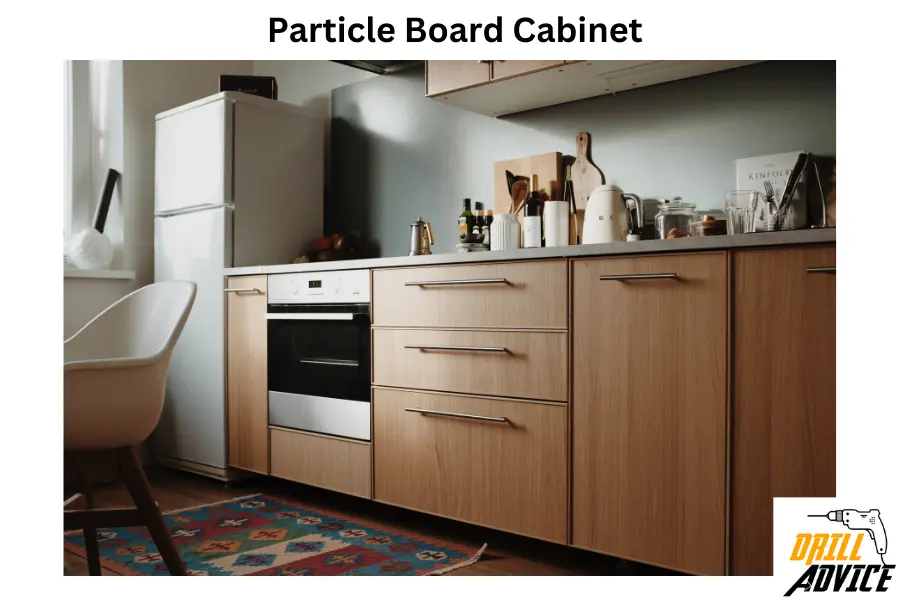
4 ft. x 8 ft particle board price is around $25 -$40. The price varies with the available thickness range (1/4 inch to 5/8 inch) of the particle board. Compared to solid wood, it is a more affordable option, making it popular for those on a budget.
Particle board is a relatively durable material for kitchen cabinets. It is recommended for its ability to withstand regular use. However, it is important to note that particle board is more susceptible to damage from water, heat, fire, and insects compared to other materials. Proper care and maintenance are essential to ensure the longevity of particle board cabinets.
Particle board is a lightweight material, making it easier to handle and install compared to solid wood. It can be easily cut and shaped using standard woodworking tools. Drilling into particle board is also relatively straightforward. However, particle board does not have the same structural integrity as solid wood, so caution must be exercised to avoid splitting or damaging the material. Finishing particle board can be more challenging compared to solid wood, as it is more porous and may require multiple coats of paint or sealant.
Particle board is known for its smooth and uniform appearance. It can be finished with a variety of laminates, veneers, or paint to achieve the desired aesthetic. However, it is important to note that particle board does not have the same natural beauty or grain patterns as solid wood. Over time, particle board may show signs of wear and tear, such as chipping or peeling of the laminate or veneer.
Advantages of Particle Board Kitchen Cabinet Material
- Affordable price compared to solid wood.
- Lightweight and easy to handle.
- Can be easily cut and shaped using standard woodworking tools.
- Various finish options available.
Disadvantages of Particle Board Kitchen Cabinet Material
- Less durable and more susceptible to damage from water, heat, fire, and insects compared to other materials.
- Requires proper care and maintenance to prevent damage.
- Not as visually appealing as solid wood.
- May show signs
5. Plywood
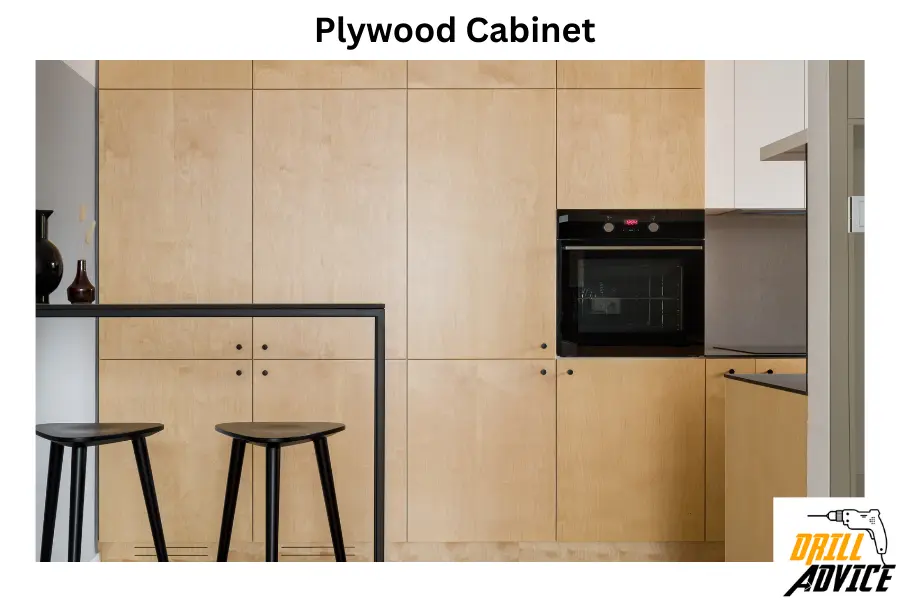
Plywood kitchen cabinet material is priced around $25-$45 for the 4 ft. x 8 ft plywood board. Plywood price is varied with the thickness of the plywood material. Compared to solid wood, plywood is a more cost-effective option, making it a popular choice for those looking for quality cabinets at a reasonable price.
Plywood is a highly durable material for kitchen cabinets. It is recommended for its ability to withstand everyday use and maintain its structural integrity over time. Plywood is also resistant to water, heat, fire, and insects, ensuring that your cabinets will remain in excellent condition for years to come.
Plywood is a lightweight material, making it easier to handle and install compared to solid wood. It can be easily cut and shaped using standard woodworking tools. Drilling into plywood is straightforward, and it holds screws securely. When it comes to finishing, plywood can be painted, stained, or veneered to achieve the desired look, just like solid wood.
Plywood has a clean and modern aesthetic appeal. It has a smooth surface and uniform appearance, making it suitable for various design styles. Plywood can be left exposed for a minimalist and contemporary look, or it can be finished with veneers or laminates to mimic the appearance of solid wood. Over time, plywood maintains its visual appeal, with minimal warping or fading.
Advantages of Plywood Kitchen Cabinet Material
- Cost-effective option compared to solid wood.
- Highly durable and resistant to water, heat, fire, and insects.
- Lightweight and easy to handle and install.
- Can be easily cut, shaped, and drilled using standard woodworking tools.
- Versatile finish options available.
Disadvantages of Plywood Kitchen Cabinet Material
- It may not have the same natural beauty or grain patterns as solid wood.
- Limited availability of high-quality plywood in some areas.
6. Melamine
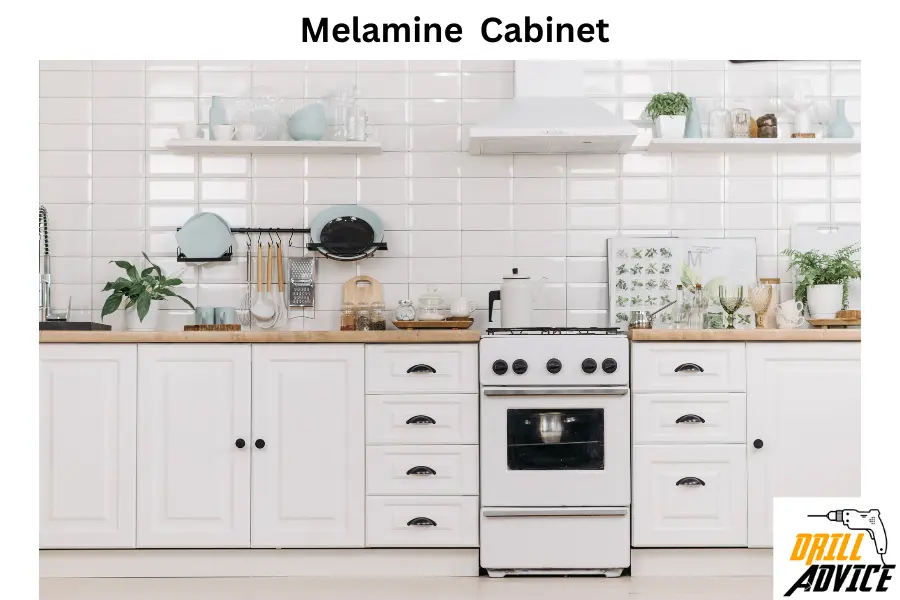
Melamine is an affordable option for kitchen cabinets. 4 ft. x 8 ft melamine board price is varied between $20-$35. The price range will be varied with the thickness of the melamine board. Melamine is a more cost-effective choice compared to solid wood.
Melamine is known for its durability and long-lasting nature. It is recommended for its resistance to moisture, heat, fire, and insects. Unlike solid wood, melamine cabinets are not prone to warping or cracking when exposed to water or heat. Additionally, they are resistant to fire and do not attract insects or pests.
Melamine is a lightweight material, making it easier to handle and install. Its density and composition allow for precise cutting and drilling, resulting in clean and accurate edges. Unlike solid wood, melamine does not require special tools or techniques for finishing, as it comes with a pre-finished surface.
Melamine offers a wide range of aesthetic options, including various colors, patterns, and textures. It can mimic the look of wood grains, marble, or even metallic finishes. The material’s surface is smooth and easy to clean, maintaining its original appearance over time. However, it’s important to note that melamine may not provide the same level of natural beauty and warmth as solid wood.
Advantages of Melamine
- Affordable price compared to solid wood
- High durability and resistance to water, heat, fire, and insects
- Lightweight and easy to work with
- Versatile aesthetic options with a smooth and easy-to-clean surface
Disadvantages of Melamine
- May not offer the same natural beauty as solid wood
- Limited repair options if damaged
- Can be susceptible to chipping or peeling if not properly cared for
7. PVC

PVC is a cost-effective option for kitchen cabinets, with an average price of $60 to $80 per linear foot. While it may be pricier compared to melamine and it is still more affordable than solid wood.
PVC is highly durable and recommended for kitchen cabinets. It is resistant to moisture, heat, fire, and insects, making it a long-lasting choice. PVC cabinets do not warp or crack when exposed to water or heat, and they are fire-resistant and do not attract insects or pests.
PVC cabinets are lightweight, making them easy to handle and install. They can be easily cut, drilled, and shaped to fit specific design requirements. However, it’s important to note that PVC cabinets may require specialized tools and techniques for proper cutting and installation, unlike solid wood, which is more versatile in terms of workability.
PVC cabinets offer a sleek and modern aesthetic appeal. They come in a variety of colors and finishes, allowing for customization to match any kitchen design. Unlike other materials, PVC cabinets maintain their appearance over time, as they are resistant to fading, discoloration, and wear. The smooth surface of PVC cabinets also makes them easy to clean and maintain.
Advantages of PVC
- Cost-effective compared to solid wood
- High durability and resistance to water, heat, fire, and insects
- Lightweight and easy to handle and install
- Sleek and modern aesthetic appeal with a wide range of color and finish options
- Maintains its appearance over time with minimal maintenance
Disadvantages of PVC
- May require specialized tools and techniques for cutting and installation
- Limited repair options if damaged
- May not provide the same natural look and warmth as solid wood
8. MDF
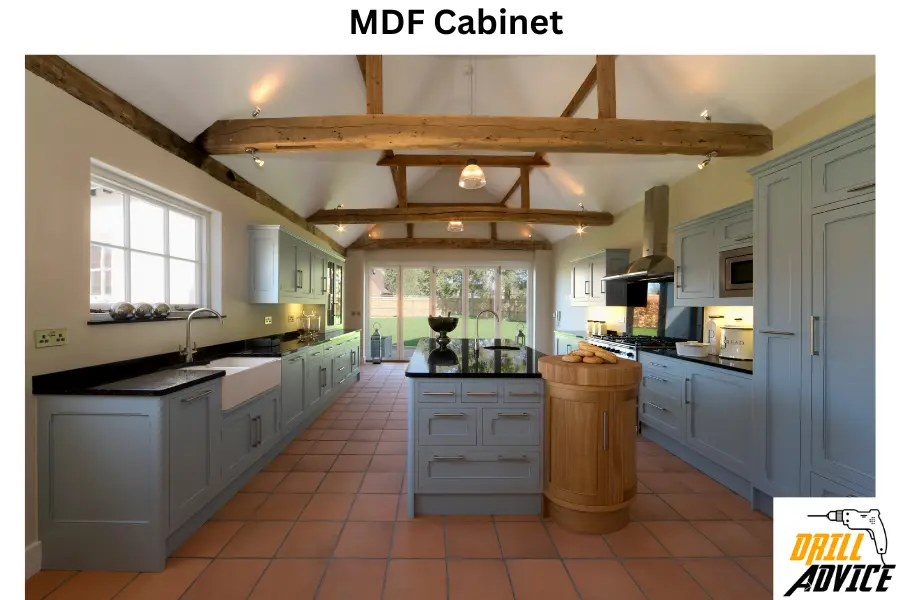
MDF (Medium Density Fiberboard) is a cost-effective option for kitchen cabinets, with an average price of $50 to $70 per linear foot. While it may be more expensive compared to melamine or PVC. It is still more affordable than solid wood.
MDF is a durable material that is recommended for kitchen cabinets. It has good resistance to moisture and can withstand moderate exposure to water. However, it is important to protect MDF cabinets from excessive moisture, as prolonged exposure can cause swelling or warping. MDF is also not as heat-resistant as other materials and can be damaged by direct contact with high heat. It is not fire-resistant and can be susceptible to insect damage if not properly treated.
MDF is a relatively lightweight material, making it easy to handle and install. It is also easy to cut, shape, and drill, allowing for precise customization. However, it is important to note that MDF does not have the same structural strength as solid wood, so extra care must be taken when handling and installing heavy items. When it comes to finishing, MDF provides a smooth and consistent surface, but it is not suitable for direct staining as it lacks the natural grain pattern of solid wood.
MDF cabinets offer a versatile aesthetic appeal. They can be painted in a variety of colors and finishes, allowing for customization to match any kitchen design. Over time, MDF cabinets maintain their appearance well, with minimal fading or discoloration. However, it’s important to note that MDF may not provide the same level of natural beauty and warmth as solid wood.
Advantages of MDF
- Cost-effective compared to solid wood
- Good resistance to moisture with proper protection
- Lightweight and easy to handle and install
- Versatile aesthetic options with the ability to paint in various colors and finishes
- Maintains its appearance well over time
Disadvantages of MDF
- Susceptible to swelling or warping with excessive moisture exposure
- Not as heat-resistant as other materials, can be damaged by high heat
- Not fire-resistant, requires proper treatment for protection
- Lacks the natural grain pattern and warmth of solid wood
9. Stainless Steel

Stainless steel is a premium option for kitchen cabinets, with an average price of $200 to $300 per linear foot. It is more expensive compared to solid wood, which can range from $100 to $300 per linear foot.
Stainless steel is highly durable and recommended for kitchen cabinets. It is resistant to moisture, heat, fire, and insects, making it a long-lasting choice. Stainless steel cabinets do not warp, crack, or rot when exposed to water or heat. They are also fire-resistant and do not attract insects or pests.
Stainless steel cabinets are heavier compared to other materials, making them sturdy and durable. They are not as easy to cut or shape as wood, and specialized tools and techniques may be required for customization. However, stainless steel cabinets are resistant to scratches and stains, making them low maintenance and easy to clean. They also have a smooth and polished finish.
Stainless steel cabinets offer a sleek and modern aesthetic appeal. They have a timeless and contemporary look that can complement various kitchen designs. Stainless steel maintains its appearance well over time, resisting rust, fading, and discoloration. It can give a professional and high-end appearance to the kitchen.
Advantages of Stainless Steel
- High durability and resistance to water, heat, fire, and insects
- Sturdy construction and longevity
- Low maintenance and easy-to-clean
- Sleek and modern aesthetic appeal
- Timeless and contemporary look
Disadvantages of Stainless Steel
- Higher price compared to solid wood
- Not as easy to cut or shape as wood, requiring specialized tools
- Can show fingerprints and smudges more easily
- Reflects light, which may cause glare in brightly lit kitchens
10. Glass
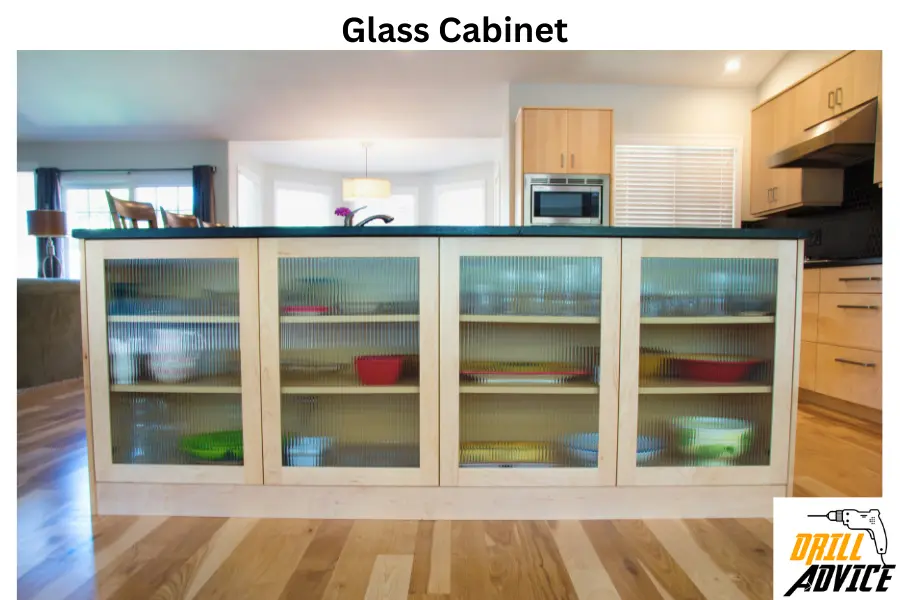
Glass is a premium option for kitchen cabinets, with an average price of $250 to $350 per linear foot. It is more expensive compared to solid wood, which can range from $100 to $300 per linear foot.
Glass cabinets are durable and recommended for kitchen use. While glass itself is not affected by water, heat, or fire, the durability of glass cabinets depends on the type of glass used. Tempered or safety glass is highly recommended as it is more resistant to impacts and less likely to break. Glass cabinets are not susceptible to insect damage.
Glass cabinets are relatively lightweight compared to other materials. However, glass cannot be easily cut or shaped like wood, and professional expertise is required for customization. Drilling holes in glass cabinets should be done with caution to prevent cracks or breaks. Glass cabinets typically have polished edges and can be finished with various decorative options such as etching, frosting, or tinting.
Glass cabinets offer a sleek and modern aesthetic appeal. They create an open and airy feel, making the kitchen space appear larger and more spacious. Glass cabinets allow for the display of dishes, glassware, or decorative items, adding a touch of elegance and sophistication to the kitchen. Over time, the aesthetic appeal of glass cabinets remains intact, as glass does not fade, discolor, or warp.
Advantages of Glass
- Sleek and modern aesthetic appeal
- Creates an open and spacious feel in the kitchen
- Durable with tempered or safety glass
- Allows for the display of dishes and decorative items
- Does not fade, discolour, or warp over time
Disadvantages of Glass
- Higher price compared to solid wood
- Requires professional expertise for customization
- It can be prone to fingerprints and smudges
- Requires careful handling to prevent breakage or cracks
